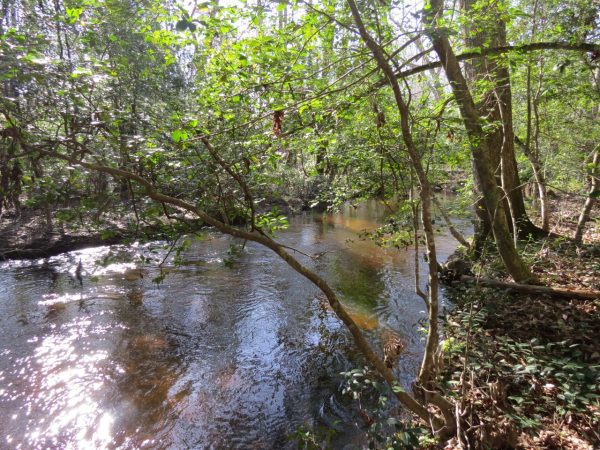Preserving a ‘black water’ river east of Charlotte: Drowning Creek

In the far southeastern tip of Montgomery County, where Moore, Richmond and Montgomery counties all converge, a stream with an evocative name flows: Drowning Creek.
Drowning Creek is a high quality stream, which means it has little pollution and good aquatic diversity. The creek flows southward into the Lumber River, which was originally called Drowning Creek.
The area around Lumberton was important for the area’s thriving lumber industry, as well as the turpentine industry, and many of the logs were transported by the river (hence the name). Since Three Rivers Land Trust merged with the Sandhills Area Land Trust, we are working on several projects along Drowning Creek.
Those projects include a 200-acre conservation easement on a property in Montgomery County that’s being restored to longleaf pine savanna. That project is partially being funded by the Clean Water Management Trust Fund. A 90-acre conservation easement on a property in Richmond County will protect a forested buffer along the stream.
Unlike the Lumber River downstream, Drowning Creek is still in the transition area between the Piedmont and Sandhills. As such, it has some of the characteristic swamp-like conditions, mixed with some bluffs and rocky outcrops.

Animal tracks along Drowning Creek. Photo: Crystal Cockman
The Lumber River flows south, forming the border between Scotland and Hoke counties, before entering South Carolina. It then confluences with the Little Pee Dee River, which flows into the Pee Dee River. It’s a popular recreation destination, and has the designation of being a National Wild and Scenic River.
President Lyndon Johnson signed the Wild and Scenic Rivers Act into law on Oct. 2, 1968. This law created the National Wild and Scenic Rivers System, designed to “to preserve certain rivers with outstanding natural, cultural, and recreational values in a free-flowing condition for the enjoyment of present and future generations.” As of 2018, 12,700 miles of 209 rivers in 40 states and Puerto Rico are designated National Wild and Scenic Rivers.
The Lumber River is the only black water river in North Carolina that has the National Wild and Scenic Rivers designation. Black water rivers are so named because of the tea-stained colored water that comes from the river flowing slowly through a forested landscape, where vegetation settles in the stream and tannins from it are leached out, resulting in the dark colored water.
The Drowning Creek area and the Lumber River area are both important from an archeological sense as well, being home to various Native American tribes. Many artifacts have been found in these areas and a number of important archeological sites are known to be on these riverbanks.
Crystal Cockman is Land Protection Director at Three Rivers Land Trust.